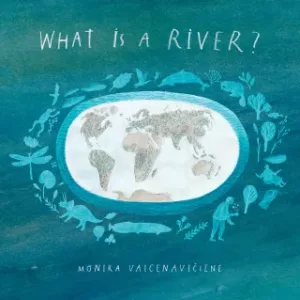An Illustrated Love Letter to Rivers
INSPIRATIONAL, 13 Sep 2021
Maria Popova | Brain Pickings – TRANSCEND Media Service
 A painted landscape of fact and feeling along the flow of existence.
A painted landscape of fact and feeling along the flow of existence.
“There is a mystery about rivers that draws us to them, for they rise from hidden places and travel by routes that are not always tomorrow where they might be today,” Olivia Laing wrote in her stunning meditation on life, loss, and the wisdom of rivers after she walked the River Ouse from source to sea — the River Ouse, in which Virginia Woolf slipped out of the mystery of life, having once observed that “the past only comes back when the present runs so smoothly that it is like the sliding surface of a deep river.”
Rivers are the crucible of human civilization, pulsating with the might and mystery of water, their serpentine paths encoded with the precision of pi, their ceaseless flow encoded in our greatest poems.
“Time is a river that sweeps me along, but I am the river,” Borges wrote in his timeless refutation of time.
But what is a river?
That is what Lithuanian illustrator and storyteller Monika Vaicenavičienė contemplates in What Is a River? (public library) — part prose poem and part encyclopedia, exploring the many things a river is and can be, ecologically and existentially.
The story begins on the banks of a river, with a little girl picking flowers — “every flower has a meaning” — and watching her grandmother sew. What unfolds is framed as the grandmother’s answer to the girl’s question of what a river is:
A river is a thread.
It embroiders our wold with beautiful patterns.
It connects people and places, past and present.
It stitches stories together.
The narrative weaves in the encyclopedic — geology and history, curious statistics about famous rivers — but fact and feeling remain entwined in the poetic.
A river is a journey.
A bubbling spring, a gap in a glacier, a boggy marsh, a silent lake — a river can begin anywhere.
A river travels to many places: prairies and cities, dense forests and lush meadows, steppes and tundra, mountains and valleys. It travels through heat and cold. It leaps from dizzying heights, cascading down as a waterfall. It slinks lazily through marshes. Suddenly, it twists, then meanders. It creeps underground. It carves canyons out of mountains, reducing rock to sediment.
We see the river as home, called to imagine how many human lives the Nile touches in a single day along its 4,100-mile meander across Africa, or the Danube across the ten countries it traverses in Europe (my own native Bulgaria among them).
We see the river as a habitat, to creatures as various as the hippo and the heron, the dragonfly and the platypus.
We see the river as a meeting-place, a muse, a name-source of countries and people, a sensory landscape, an emissary of deep time.
Myth and fact converge into a larger reflection on the ceaseless flow of existence, linking the Ancient Greek myth of Oceanus — the great river encircling the Earth, from which the word ocean derives — with the ecological reality of Earth’s immense, interconnected, ancient system of water circulating through the atmosphere and pulsating through the biosphere.
Complement What Is a River? with Italian artist Alessandro Sanna’s watercolor serenade The River, then revisit poet, painter, and philosopher Etel Adnan on the mountain as a lens on the meaning of life.
_______________________________________
Illustrations courtesy of Enchanted Lion Books; photographs by Maria Popova
 Brain Pickings is the brain child of Maria Popova, an interestingness hunter-gatherer and curious mind at large obsessed with combinatorial creativity who also writes for Wired UK and The Atlantic, among others, and is an MIT Futures of Entertainment Fellow. She has gotten occasional help from a handful of guest contributors. Email: brainpicker@brainpickings.org
Brain Pickings is the brain child of Maria Popova, an interestingness hunter-gatherer and curious mind at large obsessed with combinatorial creativity who also writes for Wired UK and The Atlantic, among others, and is an MIT Futures of Entertainment Fellow. She has gotten occasional help from a handful of guest contributors. Email: brainpicker@brainpickings.org
Go to Original – brainpickings.org
Tags: Inspirational
DISCLAIMER: The statements, views and opinions expressed in pieces republished here are solely those of the authors and do not necessarily represent those of TMS. In accordance with title 17 U.S.C. section 107, this material is distributed without profit to those who have expressed a prior interest in receiving the included information for research and educational purposes. TMS has no affiliation whatsoever with the originator of this article nor is TMS endorsed or sponsored by the originator. “GO TO ORIGINAL” links are provided as a convenience to our readers and allow for verification of authenticity. However, as originating pages are often updated by their originating host sites, the versions posted may not match the versions our readers view when clicking the “GO TO ORIGINAL” links. This site contains copyrighted material the use of which has not always been specifically authorized by the copyright owner. We are making such material available in our efforts to advance understanding of environmental, political, human rights, economic, democracy, scientific, and social justice issues, etc. We believe this constitutes a ‘fair use’ of any such copyrighted material as provided for in section 107 of the US Copyright Law. In accordance with Title 17 U.S.C. Section 107, the material on this site is distributed without profit to those who have expressed a prior interest in receiving the included information for research and educational purposes. For more information go to: http://www.law.cornell.edu/uscode/17/107.shtml. If you wish to use copyrighted material from this site for purposes of your own that go beyond ‘fair use’, you must obtain permission from the copyright owner.











